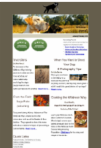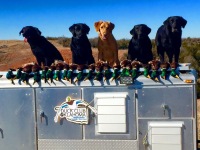We all know about cover girls, super models boasting glamorous fashion, hair of extreme styling with, of course, expensive jewelry and cosmetics applied to perfection. They grace the covers of glossy magazines in an effort to attract attention to the publication or its content. Similarly we may see photos of beautiful canines on the covers of sporting and canine enthusiast magazines; Deke displayed on the cover of the Dec, 2012 issue of Garden & Gun and Whiskey on the cover of Pheasants Forever, September, 2009. Many dogs are photographed for the covers of publications, perhaps they could be considered cover dogs but that’s not our intent when we speak of “cover dogs” at Wildrose.
A proper cover dog is a gundog of durability, instinct and persistence that literally devastates the thickest of cover (land or on water) to locate or recover birds. Naturally, a cover gundog in action is, too, a thing of beauty to behold. But I remain fairly confident that a “cover dog” is a bit more practical and perhaps more affordable for the average destination wingshooter than our former example of cover models.
Training the Wildrose Way is all about gamefinding, locating birds that otherwise would not be flushed to the gun or lost after a fall. In field situations a dog’s nose must know, so we cannot underestimate the importance of genetics in this discussion. The Wildrose Way is bringing out the natural ability of each dog, applying controls and training handlers. The nose, a gift of progeny, must be developed to each dog’s scenting potential.
Hunt on Command: The retriever will hold an area searching in a tight pattern using intense nose work as well as eyes rather than run about searching randomly or by taking a straight line.
Throw Down: The dog is instructed to hunt cover with no seen object present. As the dog covers the ground thoroughly, a “find” is tossed in (scented tennis ball or feather-laced puppy bumper). The throw down prevents the dog from being rewarded by locating the object without a thorough hunt first or in a case where the dog is not responsive to the handler’s directions.
Combining the hunt on command with the throw-down technique will require the dog to give three solid stops and recasts around the fall area or to different areas in close proximity before the object is tossed in to be located.
TARGETING
The targets (small areas to be searched) are usually thick clumps of tall grass, small thickets of dense brush or my favorite, small brush piles. Each gives the dogs a visual, contrasting bit of cover on which to focus. I will have several small piles in close proximity. Each pile will be hunted thoroughly before casting to the next. Finally, the “find” is tossed in once I am satisfied with the dog’s hunting enthusiasm and willingness to respond to whistles and hand signals.
This technique is similar to the pattern used to train canines for narcotic or ordinance location. The object is hidden in locations where the target is likely to be found in real-life situations. In our case, where would a wounded bird likely hide…. under brush, behind logs, holes in the ground, fallen tree tops, marsh grass at a water’s edge? Teach the dog to recognize these likely hiding places and search them thoroughly. Dogs are place-oriented, Wildrose Law #9. These pre-established places of reference will become fixed in the dog’s memory through repetition. “Birds will likely be found here!”
Our kennel men have constructed numerous small piles of brush and limbs in different locations about the Wildrose training grounds in woodlands, at water’s edge and in grass fields. This task becomes the first step in preparing to develop a superb game finder in cover.
THE PROCESS
- Establish the desirable cover. Begin with small brush piles as discussed.
- Establish a hunt command and ensure your dog will hold the area hunting carefully. Note: The vast majority of participants attending our workshops have never established a hunt command!
- Hunt- Stop- Hunt.
- Hunt the first brush pile or defined cover. Hold the dog until a thorough hunt is achieved.
- Stop and hold the dog’s attention briefly, then cast to the next pile.
- Repeat (a) followed by yet another stop and cast to the next target area.
- Finally, after several brief hunts of different areas, toss in your scented object.
The dog will achieve confidence in you as a handler as well as come to recognize potential target areas in the field… places where birds will likely be found. As a special high-value reward, occasionally incorporate cold game birds as finds.
With repetition you imprint these specific areas in your dog’s mind, just where a wounded bird may steel away. Once confidence is achieved, lengthen the distance to target areas requiring the dog to line to the visible area then stop and hunt.
EXTENSIONS
The dog is sent on a short line to the first cover area. Require a thorough hunt ensuring the dog sticks his nose in and around the area including an air search (hides off the ground). Once satisfied, cast the dog to another area which should be in very close proximity. As the dog searches, walk closer to the area of activity. Keep the searches going as if a dot-to-dot game. Search one bit of cover to the next as you slowly approach. Finally, you will be close enough to toss in your find in the appropriate target area/pile. Success builds upon success.
The throw down allows the handler to control the find only when the dog is handling well and searching the correct cover enthusiastically. These are exercises that forge a productive relationship between gundog and handler plus they instill in the dog’s memory areas that are potential “targets” as holders of game. Finally set up these exercises as lining for piles/cover at distances with bumpers or birds pre-hidden as permanent unseens or cold unseens.
The “cover dog” is all about enhanced game finding…bringing back birds that otherwise would be lost. At the end of the day it’s the birds in the bag that count.





